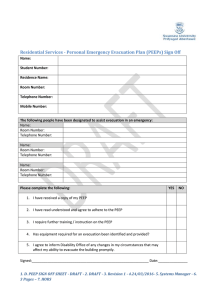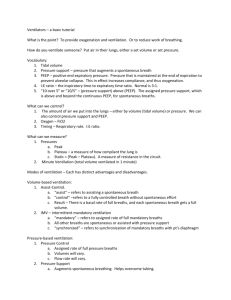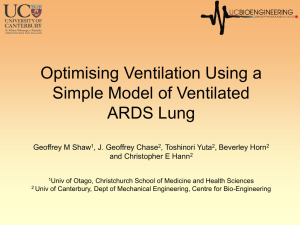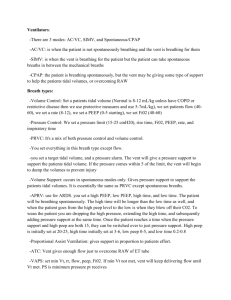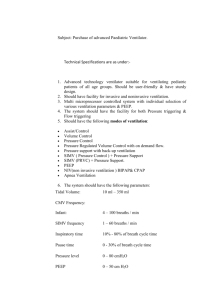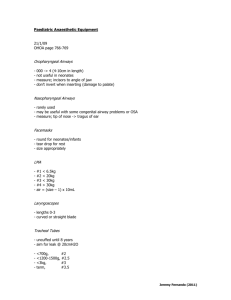Mechanical Ventilation Flow-Triggering Flow
advertisement
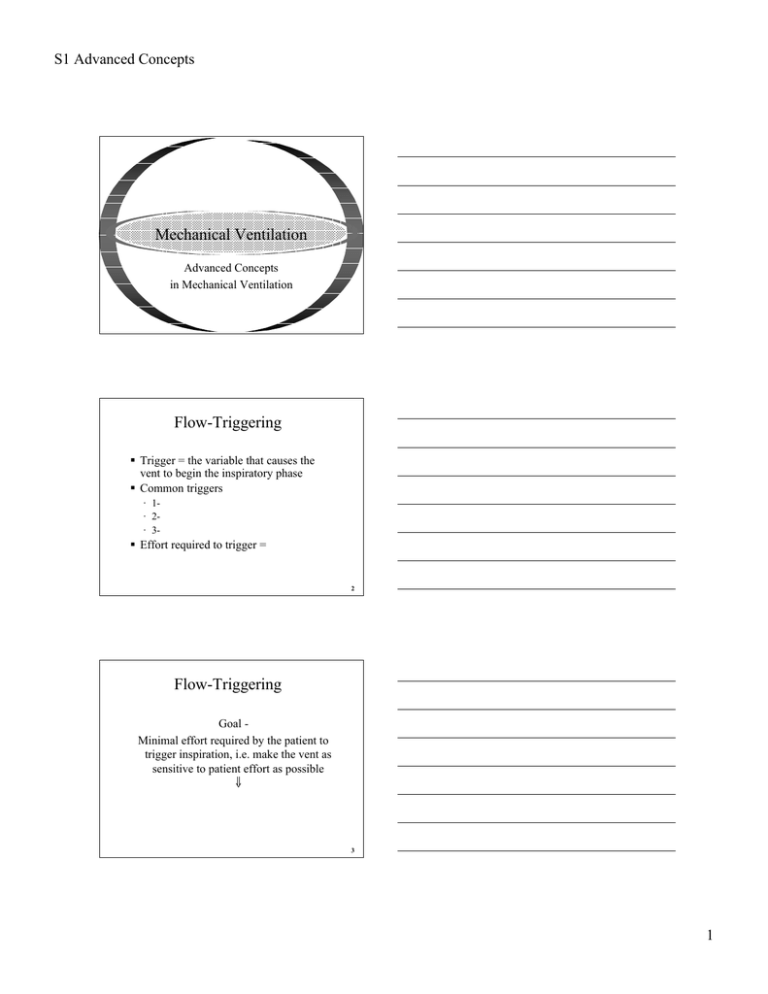
S1 Advanced Concepts Mechanical Ventilation Advanced Concepts in Mechanical Ventilation Flow-Triggering Trigger = the variable that causes the vent to begin the inspiratory phase Common triggers · 1· 2· 3- Effort required to trigger = 2 Flow-Triggering Goal Minimal effort required by the patient to trigger inspiration, i.e. make the vent as sensitive to patient effort as possible ! 3 1 S1 Advanced Concepts Flow-Triggering Flow-triggering is available on the Bennett 7200, Hamilton Galileo, Servo 300, Drager, Bear Cub, etc. 4 How Does It Work? Vent 10 LPM Patient 8 LPM 5 Ventilator Differences Bennett 7200 Base Flow: variable 0 - 20 lpm Flow Sensitivity: variable 1 - 1/2 base flow 6 2 S1 Advanced Concepts Ventilator Differences Servo 300 Base Flow: preset Flow Sensitivity: adult pedi neo 2 lpm 1 lpm .5 lpm 7 Effects of Flow-Triggering patient insp effort " fresh gas immediately available to patient " # delay time between insp effort & supply of gas ! 8 Modes - Pressure Began with IPPB treatment Fell out of use for CMV Returned with new technology PCV, PSV, PRVC, PCIRV 9 3 S1 Advanced Concepts Modes - Pressure Remember - volume ventilation: · operator sets volume · vol delivered until preset vol or time · press generated prop. to CL, RAW When set V, F " sets TI When set V, TI " sets F press varies 10 Modes - Pressure Important to remember! If patient flow demand > set flow ! “flow starvation” ! $ WOB 11 Modes - Pressure Pressure ventilation # operator sets pressure # volume varies with CL, RAW 12 4 S1 Advanced Concepts Modes - Pressure If patient “fights” vent, splints pain, CL # and/or RAW $ ! 13 Modes - Pressure Time or flow-cycled Pressure-limited Set press reached quickly & maintained t/o inspiratory time Vent delivers whatever flow is necessary to maintain press & meet patient demand 14 Modes - Pressure The most significant difference between volume & pressure-based ventilation is how the flow is delivered! 15 5 S1 Advanced Concepts PCV vs. PSV PCV PSV Cycled T F Limited P P PEEP yes yes Set Rate yes (AC) no 16 PCV vs. PSV PCV Set Rate PSV yes no PCV (C) PCV (AC) SIMV (PC) SIMV (PC)+PS PCIRV Patient has control over RR, TI, flow, V T VT depends on ∆P, pt. effort, C L, RAW 17 Clinical Advantages of PCV Little published on optimal flow pattern Evidence suggests decelerating flow pattern: · improves gas distribution in lungs allowing ventilation with same VT but lower PIP · increases patient comfort when flow responsive to demand 18 6 S1 Advanced Concepts PV Reduces V/Q Mismatch Difficult to ventilate if CL, RAW differ from one lung region to another Some areas over-ventilated, some under-ventilated Airways with $ RAW take longer to receive VT 19 PV Reduces V/Q Mismatch With PV, gas flow is high early in insp " flow reaches small airways early " allows more time for gas to be distributed according to regional CL & RAW # as press gradient # " flow slows " laminar flow when gas enters small airways # better gas distribution (# V/Q mismatch) 20 PV Optimizes TI By observing flow pattern, TI can be optimized lpm t 21 7 S1 Advanced Concepts PV Matches Flow with Patient Demand With volume ventilation, sometimes difficult to match vent flow to patient demand " patient/vent asynchrony ! 22 PV Matches Flow with Patient Demand Use of PS helps only on spontaneous breaths Increasing flow rate > demand causes turbulent flow " PIP $, hit press limit, risk of barotrauma 23 PV Matches Flow with Patient Demand Use of pressure ventilation with decelerating flows matches flow rate to patient demand ! 24 8 S1 Advanced Concepts Remember! PCV - VT delivered varies with: · · · · · CL RAW Set pressure TI PEEP level 25 Remember! PSV - VT delivered varies with: · · · · CL RAW Set pressure Patient effort 26 Primary Indication for PV ARDS in patients that volume ventilation with PEEP does not seem to be working: · · · · · FIO2 1.0 PIP ≥ 50 cmH2O PEEP ≥ 15 cmH2O RR ≥ 16/min decreasing PaO2 and CL 27 9 S1 Advanced Concepts Initial Settings PIP 1/2 - 3/4 previous PIP I:E - 1:1 to 1:2 28 PCIRV Primary use - ARDS where CL ## Lungs empty very quickly so can use short TE Patients sedated and paralyzed 2:1, 3:1, 4:1, etc. 29 PCIRV Results · oxygenation improves · gas exchange improves · PIP decreases (# risk of barotrauma & CV side-effects) · decreases need for PEEP · MAP increases · can cause auto-PEEP 30 10 S1 Advanced Concepts Monitoring PCIRV VT SpO 2 CVP RR ABG PAP VE HR PCWP PIP UO PVR MAP BP PETCO 2 CL QT P(a-ET) CO 2 waveforms PEEP auto-PEEP 31 PRVC/APV Pressure Regulated Volume Control/Adaptive Pressure Ventilation PC with control over volume Assist-control Available on Servo 300 (PRVC)/Hamilton Galileo (APV) 32 PRVC/APV Set RR, TI, target VT Breath give at minimal pressure Exhaled VT compared to target VT Pressure automatically adjusted to achieve target VT (breath to breath) Set Pressure Limit high enough 33 11 S1 Advanced Concepts PRVC/APV Advantage Guarantee of VT with the least amount of pressure to deliver that volume 34 VS Volume Support (Servo 300) Automatic Pressure Support Works like PRVC/APV Spontaneous breathing mode (no rate set) Set target VT, Pressure Limit 35 VS Advantage - automatic weaning · as patient assumes more of the work of breathing " reduce target volume to 5-7 ml/kg · apnea - vent switches to PRVC · when no apnea, spont VT 5-7 ml/kg, PS ≤ 8 cmH2O " extubate 36 12 S1 Advanced Concepts Modes - Review Mode Trigger Cycled PEEP Limited AC T, Pt V, T yes F PC T, Pt T yes P SIMV (v) T, Pt V, T yes F SIMV (p) T, Pt T yes P PRVC/APV T, Pt T yes P PS Pt F yes P CPAP Pt Pt yes P 37 AutoPEEP Intrinsic PEEP Unintended PEEP Inadvertent PEEP Occult PEEP 38 AutoPEEP PEEP that develops when a new breath is delivered before expiration has ended Air-trapping, breath-stacking Cause = expiratory time is too short ! WHY? 39 13 S1 Advanced Concepts AutoPEEP Why is TE too short? · · · · · · · COPD VE > 10 lpm small ETT CL $ RR $ insp flow rate slow large VT 40 Complications of AutoPEEP 1. Increased WOB due to air-trapping (impairs respiratory muscle function) 41 Complications of AutoPEEP 2. Decreased venous return # 3. Barotrauma 42 14 S1 Advanced Concepts Complications of AutoPEEP Auto-PEEP can artificially look like LVF: But if give positive inotropic agents, diuretics " condition will get worse 43 Detecting Auto-PEEP Auto-PEEP can’t be seen on pressure manometer If monitoring digital VTE - transient reduction in volume, then lung volume stabilizes 44 Detecting AutoPEEP Best way = Graphic Wave Forms lpm t 45 15 S1 Advanced Concepts Other - AutoPEEP Patient may not be able to trigger vent (neg. pressure trigger) · must 1st pull off autoPEEP, the pull sensitivity " Pt/Vent asynchrony, $ WOB CS calculation must include autoPEEP 46 Decrease AutoPEEP Effects Increase TE · $ flows " # TI · # VT · # RR 47 Decrease AutoPEEP Effects Decrease RAW · secretion removal · bronchodilators · $ ETT size 48 16 S1 Advanced Concepts Decrease AutoPEEP Effects Permissive hypercapnia Add PEEP (85% of autoPEEP) 49 Benefits of AutoPEEP AutoPEEP can improve oxygenation when using PCIRV 50 17
